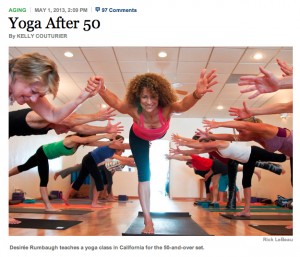Yoga – MidLife and Beyond
While many yoga classes across the country seem to cater to the youthful enthusiast who wants to sweat his or her way through an hour-and-a-half workout, a growing number of longtime yoga devotees are raising questions about the best way to safely continue a yoga practice into midlife and beyond.
“I suspect that yoga was at times an old person’s sport, and that it has prolonged the life and liveliness of people over the millennia,” said Dr. Loren Fishman, a back-pain specialist in Manhattan who uses yoga in his rehabilitation practice and has written extensively about yoga as an adjunct to medical treatment.
“Designed appropriately and taken in proper dose,” he said, “it is certainly safe.”
Carrie Owerko, a New York-based teacher of Iyengar yoga who has been a yoga student for decades, agreed. “Yoga can be practiced fully and deeply at any age,” she said, with an added caution that “the practice has to change as the body changes.”
Dr. Fishman noted that aging brings impairments of range, motion, strength and balance that can require modifications, even among veteran yogis, like using the support of a chair or the wall for many poses. In addition, students may begin to feel the effects of arthritis, injuries and other ailments that may require students skip certain poses altogether.
Someone with osteoporosis, for example, may want to avoid headstands and poses requiring extreme spinal flexion or extension, while someone with glaucoma may want to avoid taking the head below the heart in poses like headstand, handstand, shoulder stand and standing forward bends. When in doubt about the safety of practicing with any specific medical condition, Dr. Fishman recommended working with a doctor.
Generally speaking, a warm-up sequence is important for the veteran yogi, Ms. Owerko said. “Our bodies may need more time to warm up properly, especially if we are experiencing stiffness or arthritic changes in the joints or in areas that may be more vulnerable to previous injuries,” she said.
It is also important to include various one-legged standing poses — Tree Pose or Eagle Pose are examples — that challenge one’s ability to balance, even if you need the support of the wall, Ms. Owerko said. Weight-bearing poses, like Plank Pose and Forearm Plank, and standing poses like Warrior pose variations, are also important to help counteract the decline in muscle mass and strength as we age, she said.
To help maintain flexibility, poses like standing or seated forward bends and hip openers, like Bound Angle Pose or Pigeon Pose, are also important, said Roger Cole, a longtime Iyengar yoga teacher and research psychobiologist in San Diego.
Mr. Cole emphasized that a regular yoga practice can help the body maintain a high level of flexibility into midlife and beyond. If a student continues the same practice as much as possible without interruption through the 50s and beyond, he or she will see a gradual decline in certain abilities, but not necessarily a decline in flexibility, he said.
“I think the average person probably does get stiffer as they age,” he said, “but I believe that it’s mainly because they stop doing the things that keep them flexible.”
The passage of more and more baby boomer yogis, teachers as well as students, into and past middle age has sparked interest in creating a new kind of peer yoga community as well.
Desirée Rumbaugh, a longtime yoga teacher who passed the 50-year mark a few years ago, started a class in Del Mar, Calif., aimed at yoga veterans 50 and over. Called Wisdom Warriors, it was intended to offer veteran yogis the chance to keep learning in an environment that is comfortable and encouraging.
“People want to be pushed, but not in the same way they did in their 30s,” she said. “They want a little slower pace.”
Slower pace or not, Ms. Rumbaugh includes a full range of poses in her classes, including backbends and inversions. A recent Wisdom Warriors workshop, presented by Ms. Rumbaugh and Cyndi Lee at the Yoga Journal Conference in New York in April, would have been a vigorous day of yoga for students of any age.
Debra Hodgen, 61, of Vista, Calif., is a student in Ms. Rumbaugh’s class. A former dancer, she said that she began a consistent yoga practice when she was 48. She said she has become “stronger and more fearless” as a result of the class, despite having osteoarthritis, no cartilage in her right knee and joint pain throughout her body.
“I may have trouble just sitting in simple cross-legged pose, but I did full Monkey Pose recently,” she said.
The most important way a seasoned student will be able to continue to practice safely, many teachers say, is to listen to signals their body sends them in class, and know when to back off.
“In my experience, older students often bring a mature wisdom to the practice,” said Ms. Owerko, who turned 51 this week and has for many years attended an advanced yoga retreated for women over 40. “They have lived long enough to have a sense of humor about themselves. And they are often more compassionate toward themselves and other students.”
yoga over 50 – Dr. Loren Fishman .. NY TIMES 1ST MAY 2013

Comments are Closed